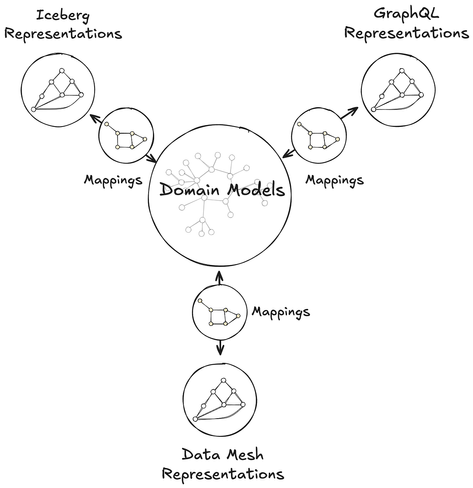Model Once, Represent Everywhere: UDA (Unified Data Architecture) at Netflix
https://netflixtechblog.com/uda-unified-data-architecture-6a6aee261d8d

Model Once, Represent Everywhere: UDA (Unified Data Architecture) at Netflix
https://netflixtechblog.com/uda-unified-data-architecture-6a6aee261d8d

Someone recently asked me about the difference between network segmentation and data segmentation after I mentioned them in a post. Both are important. Sometimes you use one method, sometimes the other, and sometimes both. And then, karma. A perfect example of data segmentation appeared on my screen a day or two later, and now I’ll share it with you.
Here’s an example of data segmentation, possibly without network segmentation. See accompanying picture.
I have multiple websites with the same hosting company. The hosting company is offering me the option of merging all of my websites under one login. That would be convenient, but it’s less secure.
At the data level, a cybercriminal must authenticate on each of the websites separately, with separate 2FA. At the network level, I have no way of knowing if the web hosting company has segmented the infrastructure, and to what degree. For some companies, detailed knowledge of the hosting company’s physical architecture is essential to good security, but for me it doesn’t matter, since I have zero confidential information stored on, or accessible from, the web servers. The worst thing a cybercriminal can do to my websites is defacement or knocking them offline.
THE LESSON
As part of your risk assessment, consider both network segmentation and data segmentation. Everything that can be accessed from the same authentication credentials is in the same data segment. The most common weakness I uncover is in granting a single Administrator account too much access.
Drawing attention to just one good quote in the article: “And it also taught many of them the importance of segmenting their networks as much as possible to contain possible damage from malware infection.”
Sadly, there’s still a long ways to go before all organizations understand the importance of not only network segmentation, but also data segmentation.
About a year ago I was at a state government industry forum (I won’t name the state) where they boasted about their ambitious goal of moving everything to the cloud and centralizing all departments’ data. In one of the breakout sessions during the Q&A period, I stood up and asked, “How are you planning to address the security risks you’re creating by total centralization?” The person on the panel who took my question said that one system they could control completely was more secure than ten or twenty systems that might have varying degrees of security. I refrained from telling them that they just admitted they sucked at project management.
#CallMeIfYouNeedMe #FIFONetworks
10 𝐌𝐢𝐬𝐭𝐚𝐤𝐞𝐬 𝐎𝐫𝐠𝐚𝐧𝐢𝐳𝐚𝐭𝐢𝐨𝐧𝐬 𝐌𝐚𝐤𝐞 𝐖𝐡𝐞𝐧 𝐌𝐨𝐝𝐞𝐫𝐧𝐢𝐳𝐢𝐧𝐠 𝐃𝐚𝐭𝐚 𝐀𝐫𝐜𝐡𝐢𝐭𝐞𝐜𝐭𝐮𝐫𝐞𝐬
Modernizing data architectures is essential for organizations seeking to stay competitive. Despite good intentions, many organizations stumble along the way, making costly mistakes that hinder progress & reduce the effectiveness of their data ecosystems.
https://foxconsulting.co/post/10-mistakes-organizations-make-when-modernizing-data-architectures
Fox Consulting helps organizations get it right the first time!
Diving into databases? Check out the difference between SQL's fixed structure and NoSQL's flexible vibe. For your hosting needs, go with xTom! #DataArchitecture #HostingMadeEasy #xTom https://xt.om/PKFt
We are Hiring!
Data warehousing
Location: Bengaluru
Submit your CV: resumes@overturerede.zohorecruitmail.in
Contact: +917428694900
Apply Now: .
https://zurl.co/IeK73
Graduate Data Analyst / Engineer (JB4992)
Alberton, Gauteng
R10 000 to R15 000 a month
Contract 6 to 12 months (May become permanent)
#DataInsights #SQL #Azure #PowerBI #Python #DataModeling #ETL #DataArchitecture #DataVisualization
ING partnered with Thoughtworks to transform its data management with a data mesh approach, moving from monolithic decentralized data architecture to a Google Cloud platform.
Read the full story here: https://ter.li/ik3ejv
What is the biggest benefit of implementing a Data Mesh approach?
Navigating the Data Engineer's Dilemma: From Pipeline Crisis to Architectural Aspirations
In the fast-paced world of data engineering, self-doubt can creep in even for seasoned professionals. As one data engineer reflects on a tumultuous 2024, they embark on a journey of growth, exploring ...
What Is Data Architecture and Why Is It Important for Your Business?
Data architecture is a framework that defines how data is collected, stored, managed, and used within an organization. It lays the foundation for effective data management, ensuring that data is accessible, secure, and optimized for decision-making.
Explore more insights on Data Architecture in our detailed blog: https://bit.ly/3DxAi2a
#Technology #Tech #Infrastructure #DataArchitecture #DataDriven #DataEngineering Cloudflare Application Security Report Highlights Surge in DDoS Attacks and CVE Exploits https://www.infoq.com/news/2024/07/cloudflare-application-security/?utm_campaign=infoq_content&utm_source=dlvr.it&utm_medium=mastodon&utm_term=Architecture%20%26%20Design #DataIntelligence #DataArchitect #DataEngineer
#Technology #Tech #Infrastructure #DataArchitecture #DataDriven #DataEngineering Navigating Software Architecture at Scale: Insights from Decathlon’s Architecture Process https://www.infoq.com/news/2024/07/decathlon-architecture-process/?utm_campaign=infoq_content&utm_source=dlvr.it&utm_medium=mastodon&utm_term=Architecture%20%26%20Design #DataIntelligence #DataArchitect #DataEngineer
#Technology #Tech #Infrastructure #DataArchitecture #DataDriven #DataEngineering Spring Ecosystem Delivers Numerous Milestone Releases https://www.infoq.com/news/2024/07/spring-releases-jul15-2024/?utm_campaign=infoq_content&utm_source=dlvr.it&utm_medium=mastodon&utm_term=Architecture%20%26%20Design #DataIntelligence #DataArchitect #DataEngineer
#Technology #Tech #Infrastructure #DataArchitecture #DataDriven #DataEngineering Navigating Software Architecture at Scale: Insights from Decathlon’s Architecture Process https://www.infoq.com/news/2024/07/decathlon-architecture-process/?utm_campaign=infoq_content&utm_source=dlvr.it&utm_medium=mastodon&utm_term=Architecture%20%26%20Design #DataIntelligence #DataArchitect #DataEngineer
#Technology #Tech #Infrastructure #DataArchitecture #DataDriven #DataEngineering Spring Ecosystem Delivers Numerous Milestone Releases https://www.infoq.com/news/2024/07/spring-releases-jul15-2024/?utm_campaign=infoq_content&utm_source=dlvr.it&utm_medium=mastodon&utm_term=Architecture%20%26%20Design #DataIntelligence #DataArchitect #DataEngineer
#Technology #Tech #Infrastructure #DataArchitecture #DataDriven #DataEngineering AWS Updates the Well-Architected Framework and Lens Catalog https://www.infoq.com/news/2024/07/well-architected-framework-lens/?utm_campaign=infoq_content&utm_source=dlvr.it&utm_medium=mastodon&utm_term=Architecture%20%26%20Design #DataIntelligence #DataArchitect #DataEngineer
#Technology #Tech #Infrastructure #DataArchitecture #DataDriven #DataEngineering Microsoft Announces General Availability of Data API Builder for Azure Cosmos DB https://www.infoq.com/news/2024/07/azure-data-api-builder-cosmos/?utm_campaign=infoq_content&utm_source=dlvr.it&utm_medium=mastodon&utm_term=Architecture%20%26%20Design #DataIntelligence #DataArchitect #DataEngineer
#Technology #Tech #Infrastructure #DataArchitecture #DataDriven #DataEngineering AWS Updates the Well-Architected Framework and Lens Catalog https://www.infoq.com/news/2024/07/well-architected-framework-lens/?utm_campaign=infoq_content&utm_source=dlvr.it&utm_medium=mastodon&utm_term=Architecture%20%26%20Design #DataIntelligence #DataArchitect #DataEngineer
#Technology #Tech #Infrastructure #DataArchitecture #DataDriven #DataEngineering Microsoft Announces General Availability of Data API Builder for Azure Cosmos DB https://www.infoq.com/news/2024/07/azure-data-api-builder-cosmos/?utm_campaign=infoq_content&utm_source=dlvr.it&utm_medium=mastodon&utm_term=Architecture%20%26%20Design #DataIntelligence #DataArchitect #DataEngineer
#Technology #Tech #Infrastructure #DataArchitecture #DataDriven #DataEngineering Pinterest Shuts Down One of the World's Largest HBase Deployments https://www.infoq.com/news/2024/06/pinterest-deprecates-hbase/?utm_campaign=infoq_content&utm_source=dlvr.it&utm_medium=mastodon&utm_term=Architecture%20%26%20Design #DataIntelligence #DataArchitect #DataEngineer